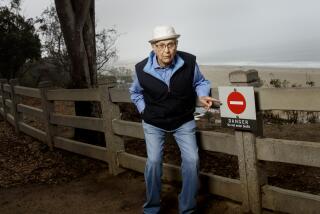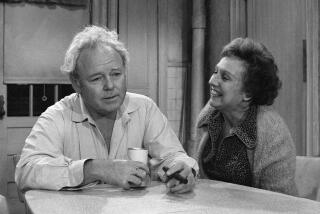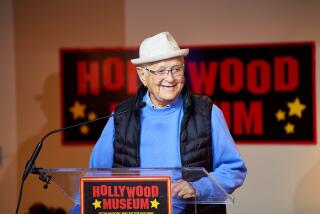From the Archives: Arlene Francis; Bubbly Wit of Early TV
- Share via
Arlene Francis, the actress and television personality who was perhaps best known as a regular panelist on the long-running quiz show “What’s My Line?”, has died. She was 93.
Francis died of natural causes Thursday afternoon at Kaiser Hospital in San Francisco.
In an era when television personalities, especially women, were expected to bubble, Francis did just that. With a ready smile and a quick wit, she was what one television reporter called “femininely gay,” a quality that helped her become one of the busiest celebrities on the small screen during the 1950s and ‘60s. In addition to “What’s My Line?”, she was the host of two shows, “Home,” a magazine-style program that followed the “Today” show on NBC, and “Talent Patrol,” an ABC variety show drawn from members of the military.
Francis was also in a number of films. She was a member of Orson Welles’ Mercury Theatre company when she met her second husband, actor Martin Gabel. They had a son, Peter, who survives her.
Born Arline Francis Kazanjian in Boston, the daughter of a noted portrait photographer, Arlene Francis exhibited a theatrical bent while attending a Catholic girls’ school. Her parents discouraged her from a career on the stage, sending her instead to an exclusive finishing school in New York City. They even tried to set her up in business as a boutique owner on Madison Avenue, but the shop was little more than a gathering place for her friends and closed in less than a year.
In short time, Francis dropped her surname, changed the spelling of her first name and headed to Hollywood. Her first film appearance was a small role as a tart who runs afoul of Bela Lugosi in “Murders in the Rue Morgue.” She went on to appear in “Stage Door Canteen,” “All My Sons,” One, Two, Three” and “The Thrill of It All.”
After her first movie, she also began a radio career, appearing on “45 Minutes in Hollywood,” doing impersonations of stage and film personalities. She was said to be adept at the vocal quirks and mannerisms of Greta Garbo.
Her success led to other work, including stints on the radio shows “March of Time” and “Cavalcade of America.” She appeared on radio programs featuring Jack Benny, George Burns and Gracie Allen, and Fred Allen. She hosted a radio show, “Blind Date,” and was the first woman to host a television game show when “Blind Date” went on ABC in 1949.
While her radio career continued to flourish, she found roles on Broadway, debuting in “One Good Year” in 1936, and had her first major role two years later in “All That Glitters.” The same year, she appeared with Welles and Joseph Cotten in “Danton’s Death,” a Mercury Theatre production. Other notable appearances included a role in Maxwell Anderson’s “Journey to Jerusalem” in 1940.
Her major Broadway hit was a 1942 production of a Joseph Fields comedy, “The Doughgirls,” in which she appeared as a Russian sniper. She played the role for a year and a half, and Look magazine reported that “she walked away with the show.”
Despite her successes on radio, stage and film, she will probably be best remembered as one of the regular panelists on “What’s My Line?”, the longest-running game show in the history of prime-time network television. Francis joined the program on its second telecast and stayed with it for the next 17 years. Hosted by John Daly, the show included panelists Bennett Cerf, Fred Allen and Dorothy Kilgallen. After the deaths of Allen and Kilgallen, the remaining regulars were joined by celebrity panelists.
The show’s premise was simple. Contestants, generally from all walks of life, were asked yes and no questions about their occupations by the four panelists, who tried to surmise the guest’s occupation. The show’s final segment included a celebrity guest, whom the panelists would question while blindfolded. The celebrities would try to disguise their voices and stump the panel.
As described in the reference, “The Complete Directory to Prime Time Network and Cable TV Shows” by Tim Brooks and Earle Marsh, “What’s My Line?” “reeked of urbanity.” The regular panel was known for its “elan and wit.”
It also influenced popular style. Francis always wore a diamond heart-shaped necklace, which Gabel gave her on their first anniversary, as a good-luck charm. The necklace started a fashion trend in the 1950s.
Francis stayed with the show after it left the network for syndication. But with new panelists like slapstick comedian Soupy Sales, the show was “considerably less sophisticated,” according to Brooks and Marsh.
Other notable turns for Francis included her role on the “Home” show, one of the early magazine-style formats in television. A master of carefree commentary, she took the show on remote broadcasts from cities around the country, including Los Angeles, where she filmed from the Beverly Hilton, the San Fernando Mission and the top of the downtown Federal Building.
In one memorable segment, Francis descended in a diving bell to the bottom of the ocean off Santa Catalina Island. Something went wrong with the air pressure and the bell shot to the surface without warning. Francis’ scream could be heard clearly coming from television sets across America. But she recovered quickly ad-libbing when she left the chamber “Wow, now I know what it feels like to be a champagne cork!”
Despite her effervescent television persona, her life was not without tragedy. In 1963, Francis was in an automobile accident on a rain-swept highway, killing a motorist in another vehicle. Francis suffered a concussion and a fractured shoulder. Three years earlier, a dumbbell propping up a window of her Manhattan apartment fell eight floors, killing a Detroit tourist who was in New York to celebrate his 60th birthday.
In 1988, a thief snatched her diamond-shaped necklace from her neck as she walked down New York’s Lexington Avenue.
Her 10-year marriage to her first husband, Neil Agnew, ended in divorce in 1945. She married Gabel a year later and the couple remained married until his death in 1986.
More to Read
Start your day right
Sign up for Essential California for the L.A. Times biggest news, features and recommendations in your inbox six days a week.
You may occasionally receive promotional content from the Los Angeles Times.







